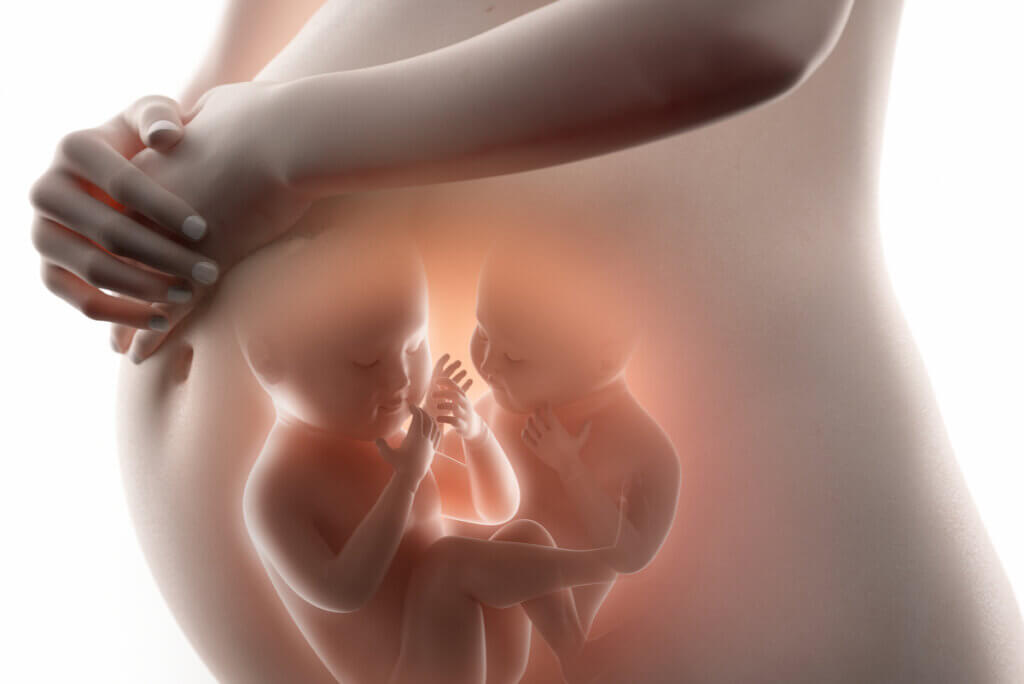Fraternal and Identical Twins? What Are the Differences

Fraternal and identical twins? What’s the difference between them? Who are the most alike? Why? Do they share DNA? Are they the same sex? In this article, we’ll answer these questions and reveal 11 differences.
The reality is that almost all of us know someone who’s a twin, but we don’t always know the real differences between the two types of twins. In both cases, we’re talking about multiple pregnancies, which are less frequent than pregnancies with a single baby.
Most multiple pregnancies involve two ovules fertilized by two sperm (making them fraternal). Despite the number, there are noticeable differences between the two types of siblings. Let’s discover what they are!
“A brother is a friend given by nature”.
-Jean Baptiste Legouve-
11 Differences between identical and fraternal twins
The differences between the two types of twins allude to different fields and concepts. They have to do, above all, not only with biology and genetics but also with psychology. Find out why!
1. Nomenclature
One of the important differences between identical and fraternal twins so as not to confuse us has to do with their nomenclature. Therefore, while identical twins are known as monozygotic twins, fraternal twins are also called bivitelline or dizygotic twins.
2. Formation of the embryos (origin)
The formation of identical and fraternal twins is another significant difference. Identical twins are monozygotic and fraternal twins are bivitelous or dizygotic. Let’s clarify these concepts:
- Univitelline or monozygotic: Twins come from a single zygote (union of the ovum and spermatozoon and subsequent division into two identical embryos).
- Bivitelline or dizygotic: Two ovules are fertilized by two different spermatozoa and two zygotes are formed in two different sacs.

3. The number of eggs/sperm
Another difference between identical and fraternal twins is the number of eggs and sperm that come into play in each case. In twins that are identical, there’s only one egg and one sperm that fuse during fertilization; subsequently, there’s a division of the zygote into two differentiated embryos.
On the other hand, in fraternal twins, there are two spermatozoa and two ovules that form two zygotes and later, embryos, that are well differentiated from the beginning.
4. Differences in DNA
Identical twins share 100% of their genetic material (DNA). On the other hand, fraternal twins only share 50% of the genes (as would occur in siblings that are not twins). This would partly explain why twins that are identical resemble each other more than fraternal twins.
5. Sex
Identical twins are always of the same sex, while fraternal twins may or may not be. This links to the point explained previously. In the case of monozygotic twins, their DNA is the same, as a single zygote has been formed through a single sperm and a single egg.
By having the same DNA, the twins must be of the same sex no matter what. On the other hand, in the case of fraternal twins, their DNA isn’t identical, as they’re formed through two ovules and two sperm.
6. Physique (phenotype)
In general, monozygotic twins are identical or very similar in appearance. On the other hand, fraternal twins tend to be more different from each other. This is also related to what was mentioned previously about DNA.
At the same time, the resemblance between twins that are identical is usually more noticeable during childhood (with the passing of time, they become different). This is, in large part, due to the influences of the environment and experiences, as well as the personal style that each one adopts.
7. The influence of genetics
Another difference between identical and fraternal twins alludes to the influence of genetics. In the case of monozycotic twins, genetic inheritance doesn’t influence their occurrence. However, in identical twins, it does play a role. Therefore, there’s a greater probability of having twins if there’s already a history in the family.
8. The influence of other factors
As we said, the probability of having twins that are identical isn’t influenced by any known variable. On the other hand, in the case of fraternal twins, the age of the mother has an influence (for example, having fraternal twins is more likely after the age of 35). Likewise, if she has undergone fertility treatment, the likelihood also increases.
9. Placentas and amniotic sacs
Identical twins can develop with 1 or 2 placentas and 1 or 2 amniotic sacs. In contrast, fraternal twins always develop with 2 placentas and 2 amniotic sacs.
It’s important to note here that sharing the placenta (in the case of monozygotic twins) is a risk factor during pregnancy that parents and doctors need to be aware of. Your gynecologist can always offer information on this and other issues that may concern you.
10. Blood type
Another difference between fraternal twins and identical twins has to do with their blood type. Monozygotic twins always have the same blood type, while blood type may or may not coincide in the case of fraternal twins.
11. Type of relationship
This is a more subjective matter, but it has been proven that, in general, identical twins have a more intense relationship than fraternal twins. This can’t be expanded to all cases nor can we determine the type of relationship (positive or negative) that twins have systematically.
But the reality is that being twins increases the probability that the relationship between the two children will be stronger. Also, let’s remember that fraternal twins are always of the same sex, which could also explain this type of union of a slightly different nature from the union between identical twins.
Studies with identical and fraternal twins

In the field of research, since the last century, studies have been carried out with identical and fraternal twins to study the influences of the environment and genetics on certain characteristics of human beings. Personalities, intelligence, and the prevalence of psychiatric or mental disorders are analyzed. Therefore, identical and fraternal twins constitute an interesting source of study to discover these complex aspects.
We’re talking about the famous science debate nature vs. nurture, that is, nature and environment/nurture. What relative weight does each of these factors have regarding personality, intelligence, and other abilities or capacities?
Individuality remains
Today, we’ve examined some of the most important differences between identical and fraternal twins. Regarding the similarities, we know for example that their fingerprints are different. What’s clear is that living the experience of having a twin constitutes something very particular.
As a final reflection, it’s interesting to emphasize that it’s always important to treat them as two different people. Let’s not make the mistake of addressing them as if they were the same person! Although they may be identical or similar on the outside, each one has their own personality and particularities. We all like to be treated as the unique beings that we are, right?
Fraternal and identical twins? What’s the difference between them? Who are the most alike? Why? Do they share DNA? Are they the same sex? In this article, we’ll answer these questions and reveal 11 differences.
The reality is that almost all of us know someone who’s a twin, but we don’t always know the real differences between the two types of twins. In both cases, we’re talking about multiple pregnancies, which are less frequent than pregnancies with a single baby.
Most multiple pregnancies involve two ovules fertilized by two sperm (making them fraternal). Despite the number, there are noticeable differences between the two types of siblings. Let’s discover what they are!
“A brother is a friend given by nature”.
-Jean Baptiste Legouve-
11 Differences between identical and fraternal twins
The differences between the two types of twins allude to different fields and concepts. They have to do, above all, not only with biology and genetics but also with psychology. Find out why!
1. Nomenclature
One of the important differences between identical and fraternal twins so as not to confuse us has to do with their nomenclature. Therefore, while identical twins are known as monozygotic twins, fraternal twins are also called bivitelline or dizygotic twins.
2. Formation of the embryos (origin)
The formation of identical and fraternal twins is another significant difference. Identical twins are monozygotic and fraternal twins are bivitelous or dizygotic. Let’s clarify these concepts:
- Univitelline or monozygotic: Twins come from a single zygote (union of the ovum and spermatozoon and subsequent division into two identical embryos).
- Bivitelline or dizygotic: Two ovules are fertilized by two different spermatozoa and two zygotes are formed in two different sacs.

3. The number of eggs/sperm
Another difference between identical and fraternal twins is the number of eggs and sperm that come into play in each case. In twins that are identical, there’s only one egg and one sperm that fuse during fertilization; subsequently, there’s a division of the zygote into two differentiated embryos.
On the other hand, in fraternal twins, there are two spermatozoa and two ovules that form two zygotes and later, embryos, that are well differentiated from the beginning.
4. Differences in DNA
Identical twins share 100% of their genetic material (DNA). On the other hand, fraternal twins only share 50% of the genes (as would occur in siblings that are not twins). This would partly explain why twins that are identical resemble each other more than fraternal twins.
5. Sex
Identical twins are always of the same sex, while fraternal twins may or may not be. This links to the point explained previously. In the case of monozygotic twins, their DNA is the same, as a single zygote has been formed through a single sperm and a single egg.
By having the same DNA, the twins must be of the same sex no matter what. On the other hand, in the case of fraternal twins, their DNA isn’t identical, as they’re formed through two ovules and two sperm.
6. Physique (phenotype)
In general, monozygotic twins are identical or very similar in appearance. On the other hand, fraternal twins tend to be more different from each other. This is also related to what was mentioned previously about DNA.
At the same time, the resemblance between twins that are identical is usually more noticeable during childhood (with the passing of time, they become different). This is, in large part, due to the influences of the environment and experiences, as well as the personal style that each one adopts.
7. The influence of genetics
Another difference between identical and fraternal twins alludes to the influence of genetics. In the case of monozycotic twins, genetic inheritance doesn’t influence their occurrence. However, in identical twins, it does play a role. Therefore, there’s a greater probability of having twins if there’s already a history in the family.
8. The influence of other factors
As we said, the probability of having twins that are identical isn’t influenced by any known variable. On the other hand, in the case of fraternal twins, the age of the mother has an influence (for example, having fraternal twins is more likely after the age of 35). Likewise, if she has undergone fertility treatment, the likelihood also increases.
9. Placentas and amniotic sacs
Identical twins can develop with 1 or 2 placentas and 1 or 2 amniotic sacs. In contrast, fraternal twins always develop with 2 placentas and 2 amniotic sacs.
It’s important to note here that sharing the placenta (in the case of monozygotic twins) is a risk factor during pregnancy that parents and doctors need to be aware of. Your gynecologist can always offer information on this and other issues that may concern you.
10. Blood type
Another difference between fraternal twins and identical twins has to do with their blood type. Monozygotic twins always have the same blood type, while blood type may or may not coincide in the case of fraternal twins.
11. Type of relationship
This is a more subjective matter, but it has been proven that, in general, identical twins have a more intense relationship than fraternal twins. This can’t be expanded to all cases nor can we determine the type of relationship (positive or negative) that twins have systematically.
But the reality is that being twins increases the probability that the relationship between the two children will be stronger. Also, let’s remember that fraternal twins are always of the same sex, which could also explain this type of union of a slightly different nature from the union between identical twins.
Studies with identical and fraternal twins

In the field of research, since the last century, studies have been carried out with identical and fraternal twins to study the influences of the environment and genetics on certain characteristics of human beings. Personalities, intelligence, and the prevalence of psychiatric or mental disorders are analyzed. Therefore, identical and fraternal twins constitute an interesting source of study to discover these complex aspects.
We’re talking about the famous science debate nature vs. nurture, that is, nature and environment/nurture. What relative weight does each of these factors have regarding personality, intelligence, and other abilities or capacities?
Individuality remains
Today, we’ve examined some of the most important differences between identical and fraternal twins. Regarding the similarities, we know for example that their fingerprints are different. What’s clear is that living the experience of having a twin constitutes something very particular.
As a final reflection, it’s interesting to emphasize that it’s always important to treat them as two different people. Let’s not make the mistake of addressing them as if they were the same person! Although they may be identical or similar on the outside, each one has their own personality and particularities. We all like to be treated as the unique beings that we are, right?
- Pacheco J. (1999). Ginecología y Obstetricia. Lima-Perú: MAD Corp SA.
- Pueyo, A. (1997). La herencia y el medio en la determinación de las diferencias individuales. En Manual de psicología diferencial (cap. 11). Madrid: McGraw-Hill.
- Rivling, M. y Martin, R. (1994). Manual of Clinical Problems in Obstetrics and Gynecology. 4ª edition. USA.
- Osorio, Cancha, and Joshyra del Pilar. “Edad materna avanzada como factor de riesgo para embarazo múltiple.” (2018).
- Hasbún, Jorge. “El riesgo perinatal y materno del embarazo gemelar.” Revista Chilena de Salud Pública 10.1 (2006): 27-34.
- Pigliucci, Massimo. Phenotypic plasticity: beyond nature and nurture. JHU Press, 2001.
Este texto se ofrece únicamente con propósitos informativos y no reemplaza la consulta con un profesional. Ante dudas, consulta a tu especialista.







